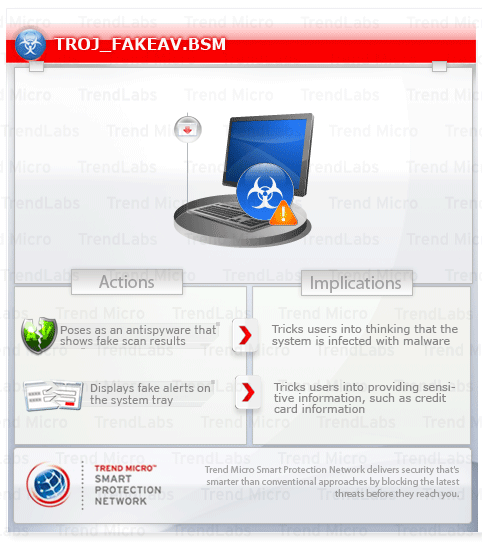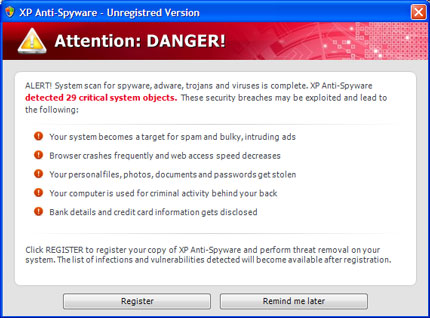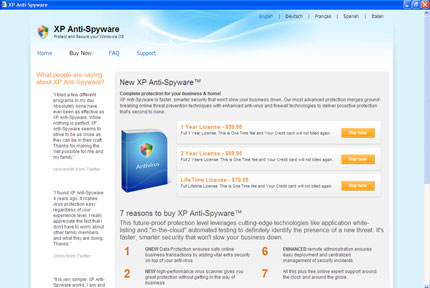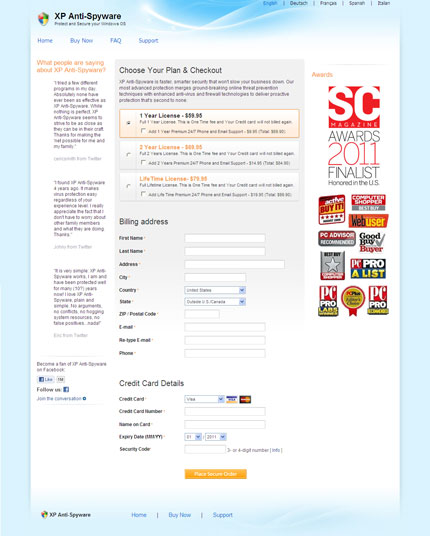TROJ_FAKEAV.BSM
Windows 2000, Windows XP, Windows Server 2003


Threat Type: Trojan
Destructiveness: No
Encrypted: No
In the wild: Yes
OVERVIEW
This Trojan has increased potential for damage, propagation, or both, that it possesses. Specifically, it is related to an attack that involves blackhat SEO poisoning of Google Image search results.
To get a one-glance comprehensive view of the behavior of this Trojan, refer to the Threat Diagram shown below.

This Trojan poses as a legitimate antivirus software using various commercial names. Similar to other FAKEAV variants, TROJ_FAKEAV.BSM also displays several graphical users interfaces (GUIs) to users in an attempt to convince them of system infection and to purchase this purported cleaning software.
It gathers sensitive information from the user they choose to purchase the product. The information gathered includes credit card and contact details.
This Trojan may be downloaded by other malware/grayware from remote sites.
It employs registry shell spawning by adding certain registry entries. This allows this malware to execute even when other applications are opened.
It deletes itself after execution.
It displays fake alerts that warn users of infection. It also displays fake scanning results of the affected system. It then asks for users to purchase it once scanning is completed. If users decide to purchase the rogue product, users are directed to a certain website asking for sensitive information, such as credit card numbers.
TECHNICAL DETAILS
237,930 bytes
EXE
Yes
28 Apr 2011
Drops files, Displays windows
Arrival Details
This Trojan may be downloaded by the following malware/grayware from remote sites:
- http://{BLOCKED}tivirus.cz.cc/fast-scan
Installation
This Trojan drops the following non-malicious files:
- C:\Documents and Settings\All Users\Application Data\{random file name}
- %Application Data%\{random file name}
- %User Profile%\Templates\{random file name}
- %User Temp%\{random file name}
(Note: %Application Data% is the current user's Application Data folder, which is usually C:\Windows\Profiles\{user name}\Application Data on Windows 98 and ME, C:\WINNT\Profiles\{user name}\Application Data on Windows NT, and C:\Documents and Settings\{user name}\Local Settings\Application Data on Windows 2000, XP, and Server 2003.. %User Profile% is the current user's profile folder, which is usually C:\Windows\Profiles\{user name} on Windows 98 and ME, C:\WINNT\Profiles\{user name} on Windows NT, and C:\Documents and Settings\{user name} on Windows 2000, XP, and Server 2003.. %User Temp% is the current user's Temp folder, which is usually C:\Documents and Settings\{user name}\Local Settings\Temp on Windows 2000, XP, and Server 2003.)
It drops the following copies of itself into the affected system:
- %Application Data%\{random file name}.exe
(Note: %Application Data% is the current user's Application Data folder, which is usually C:\Windows\Profiles\{user name}\Application Data on Windows 98 and ME, C:\WINNT\Profiles\{user name}\Application Data on Windows NT, and C:\Documents and Settings\{user name}\Local Settings\Application Data on Windows 2000, XP, and Server 2003.)
Autostart Technique
This Trojan employs registry shell spawning to ensure its execution when certain file types are accessed by adding the following entries:
HKEY_CLASSES_ROOT\.exe\shell\
open\command
(Default) = ""{malware path and file name}" -a "%1" %*"
HKEY_CLASSES_ROOT\exefile\shell\
open\command
(Default) = ""{malware path and file name}" -a "%1" %*"
HKEY_CURRENT_USER\Software\Classes\
.exe\shell\open\
command
(Default) = ""{malware path and file name}" -a "%1" %*"
HKEY_CURRENT_USER\Software\Classes\
exefile\shell\open\
command
(Default) = ""{malware path and file name}" -a "%1" %*"
Other System Modifications
This Trojan adds the following registry entries:
HKEY_LOCAL_MACHINE\SYSTEM\CurrentControlSet\
Services\SharedAccess\Parameters\
FirewallPolicy\DomainProfile
EnableFirewall = "0"
HKEY_LOCAL_MACHINE\SYSTEM\CurrentControlSet\
Services\SharedAccess\Parameters\
FirewallPolicy\DomainProfile
DoNotAllowExceptions = "0"
HKEY_LOCAL_MACHINE\SYSTEM\CurrentControlSet\
Services\SharedAccess\Parameters\
FirewallPolicy\DomainProfile
DisableNotifications = "1"
HKEY_LOCAL_MACHINE\SYSTEM\CurrentControlSet\
Services\SharedAccess\Parameters\
FirewallPolicy\StandardProfile
EnableFirewall = "0"
HKEY_LOCAL_MACHINE\SYSTEM\CurrentControlSet\
Services\SharedAccess\Parameters\
FirewallPolicy\StandardProfile
DoNotAllowExceptions = "0"
HKEY_LOCAL_MACHINE\SYSTEM\CurrentControlSet\
Services\SharedAccess\Parameters\
FirewallPolicy\StandardProfile
DisableNotifications = "1"
It modifies the following registry entries:
HKEY_LOCAL_MACHINE\SOFTWARE\Clients\
StartMenuInternet\FIREFOX.EXE\shell\
open\command
(Default) = ""{malware path and file name}" -a "%Program Files%\Mozilla Firefox\firefox.exe""
(Note: The default value data of the said registry entry is %Program Files%\Mozilla Firefox\firefox.exe.)
HKEY_LOCAL_MACHINE\SOFTWARE\Clients\
StartMenuInternet\FIREFOX.EXE\shell\
safemode\command
(Default) = ""{malware path and file name}" -a "%Program Files%\Mozilla Firefox\firefox.exe" -safe-mode"
(Note: The default value data of the said registry entry is "%Program Files%\Mozilla Firefox\firefox.exe" -safe-mode.)
HKEY_LOCAL_MACHINE\SOFTWARE\Clients\
StartMenuInternet\IEXPLORE.EXE\shell\
open\command
(Default) = ""{malware path and file name}" -a "%Program Files%\Internet Explorer\iexplore.exe""
(Note: The default value data of the said registry entry is "%Program Files%\Internet Explorer\iexplore.exe".)
HKEY_LOCAL_MACHINE\SOFTWARE\Microsoft\
Security Center
AntiVirusDisableNotify = "1"
(Note: The default value data of the said registry entry is 0.)
HKEY_LOCAL_MACHINE\SOFTWARE\Microsoft\
Security Center
FirewallDisableNotify = "1"
(Note: The default value data of the said registry entry is 0.)
HKEY_LOCAL_MACHINE\SOFTWARE\Microsoft\
Security Center
UpdatesDisableNotify = "1"
(Note: The default value data of the said registry entry is 0.)
HKEY_LOCAL_MACHINE\SOFTWARE\Microsoft\
Security Center
AntiVirusOverride = "1"
(Note: The default value data of the said registry entry is 0.)
HKEY_LOCAL_MACHINE\SOFTWARE\Microsoft\
Security Center
FirewallOverride = "1"
(Note: The default value data of the said registry entry is 0.)
Other Details
This Trojan deletes itself after execution.
Rogue Antivirus Routine
This Trojan displays fake alerts that warn users of infection. It also displays fake scanning results of the affected system. It then asks for users to purchase it once scanning is completed. If users decide to purchase the rogue product, users are directed to a certain website asking for sensitive information, such as credit card numbers.
NOTES:
It may install itself on the infected system as a rogue antivirus using the following names:
- {OS Name} Anti-Spyware
- {OS Name} Anti-Spyware 2011
- {OS Name} Anti-Virus 2011
- {OS Name} Home Security
- {OS Name} Home Security 2011
- {OS Name} Internet Security 2011
- {OS Name} Security 2011
- {OS Name} Total Security
- {OS Name} Total Security 2011
It displays the following graphical user interface (GUI):
If users decide to purchase the rogue product, they are then directed to any of following sites asking for sensitive information, such as credit card numbers:
- {BLOCKED}uboqo.com
- {BLOCKED}xuxu.com
- {BLOCKED}dar.com
- {BLOCKED}woto.com
- {BLOCKED}syfabapi.com
- {BLOCKED}jisem.com
- {BLOCKED}kypomow.com
- {BLOCKED}hulyqedy.com
- {BLOCKED}lap.com
- {BLOCKED}byfaf.com
- {BLOCKED}nax.com
- {BLOCKED}xypo.com
- {BLOCKED}kovo.com
- {BLOCKED}pacytucy.com
- {BLOCKED}pacytucy.com
- {BLOCKED}gyry.com
- {BLOCKED}vunokyk.com
- {BLOCKED}juwevul.com
- {BLOCKED}lejuj.com
- {BLOCKED}kalyn.com
- {BLOCKED}hagupy.com
- {BLOCKED}macik.com
- {BLOCKED}ragap.com
- {BLOCKED}dupi.com
- {BLOCKED}sativ.com
- {BLOCKED}hidid.com
- {BLOCKED}vywuge.com
- {BLOCKED}mywy.com
- {BLOCKED}kokazoz.com
- {BLOCKED}vynyxu.com
- {BLOCKED}nageboj.com
- {BLOCKED}cin.com
- {BLOCKED}vunevu.com
- {BLOCKED}nojy.com
- {BLOCKED}wobow.com
- {BLOCKED}wemyvuda.com
- {BLOCKED}kalyna.com
- {BLOCKED}ziqyze.com
- {BLOCKED}zyp.com
- {BLOCKED}fyqevaz.com
- {BLOCKED}zegokido.com
- {BLOCKED}rinazecit.com
- {BLOCKED}kuboqo.com
- {BLOCKED}xohyqo.com
- {BLOCKED}inejuf.com
- {BLOCKED}behasa.com
- {BLOCKED}nejuf.com
- {BLOCKED}hinynuh.com
- {BLOCKED}jimaq.com
- {BLOCKED}jez.com
- {BLOCKED}vadaqyz.com
- {BLOCKED}gapyhi.com
- {BLOCKED}tige.com
- {BLOCKED}paqatyc.com
- {BLOCKED}nena.com
- {BLOCKED}huh.com
- {BLOCKED}gevuryt.com
- {BLOCKED}sope.com
- {BLOCKED}pyf.com
- {BLOCKED}nyxorun.com
- {BLOCKED}hibijy.com
- {BLOCKED}xojis.com
- {BLOCKED}bytedotu.com
- {BLOCKED}zeno.com
- {BLOCKED}qufikeg.com
- {BLOCKED}papavi.com
- {BLOCKED}cogiqek.com
- {BLOCKED}fyp.com
- {BLOCKED}zupilog.com
- {BLOCKED}kubovu.com
- {BLOCKED}pah.com
- {BLOCKED}vykavo.com
- {BLOCKED}kun.com
- {BLOCKED}jybi.com
- {BLOCKED}hoto.com
- {BLOCKED}qoxyxyt.com
- {BLOCKED}pyzoqah.com
- {BLOCKED}pyla.com
- {BLOCKED}dabati.com
- {BLOCKED}tyn.com
- {BLOCKED}qiceq.com
- {BLOCKED}cus.com
- {BLOCKED}damaqyr.com
- {BLOCKED}nazecit.com
- {BLOCKED}ryfuwy.com
- {BLOCKED}zykubo.com
- {BLOCKED}semijawo.com
- {BLOCKED}fodafur.com
- {BLOCKED}zom.com
- {BLOCKED}byrum.com
- {BLOCKED}sotopib.com
- {BLOCKED}syfage.com
- {BLOCKED}gac.com
It may gather the following information if the user chooses to activate the product:
- Credit card information (i.e. card type, card number, expiration date, security code)
- Contact information (i.e.name, address, email, phone number)
SOLUTION
8.900
8.122.08
28 Apr 2011
8.123.00
28 Apr 2011
Step 1
For Windows XP and Windows Server 2003 users, before doing any scans, please make sure you disable System Restore to allow full scanning of your computer.
Step 2
Scan your computer with your Trend Micro product and note files detected as TROJ_FAKEAV.BSM
Step 3
Restart in Safe Mode
Step 4
Delete this registry value
Important: Editing the Windows Registry incorrectly can lead to irreversible system malfunction. Please do this step only if you know how or you can ask assistance from your system administrator. Else, check this Microsoft article first before modifying your computer's registry.
- In HKEY_LOCAL_MACHINE\SYSTEM\CurrentControlSet\Services\SharedAccess\Parameters\FirewallPolicy\DomainProfile
- EnableFirewall = 0
- EnableFirewall = 0
- In HKEY_LOCAL_MACHINE\SYSTEM\CurrentControlSet\Services\SharedAccess\Parameters\FirewallPolicy\DomainProfile
- DoNotAllowExceptions = 0
- DoNotAllowExceptions = 0
- In HKEY_LOCAL_MACHINE\SYSTEM\CurrentControlSet\Services\SharedAccess\Parameters\FirewallPolicy\DomainProfile
- DisableNotifications = 1
- DisableNotifications = 1
- In HKEY_LOCAL_MACHINE\SYSTEM\CurrentControlSet\Services\SharedAccess\Parameters\FirewallPolicy\StandardProfile
- EnableFirewall = 0
- EnableFirewall = 0
- In HKEY_LOCAL_MACHINE\SYSTEM\CurrentControlSet\Services\SharedAccess\Parameters\FirewallPolicy\StandardProfile
- DoNotAllowExceptions = 0
- DoNotAllowExceptions = 0
- In HKEY_LOCAL_MACHINE\SYSTEM\CurrentControlSet\Services\SharedAccess\Parameters\FirewallPolicy\StandardProfile
- DisableNotifications = 1
- DisableNotifications = 1
Step 5
Restore this modified registry value
Important: Editing the Windows Registry incorrectly can lead to irreversible system malfunction. Please do this step only if you know how or you can ask assistance from your system administrator. Else, check this Microsoft article first before modifying your computer"s registry.
- HKEY_CLASSES_ROOT\.exe\shell\open\command
- HKEY_CLASSES_ROOT\exefile\shell\open\command
- HKEY_CURRENT_USER\Software\Classes\.exe\shell\open\command
- HKEY_CURRENT_USER\Software\Classes\exefile\shell\open\command
Step 6
Restore this modified registry value
Important: Editing the Windows Registry incorrectly can lead to irreversible system malfunction. Please do this step only if you know how or you can ask assistance from your system administrator. Else, check this Microsoft article first before modifying your computer's registry.
- In HKEY_LOCAL_MACHINE\SOFTWARE\Clients\StartMenuInternet\FIREFOX.EXE\shell\open\command
- From: (Default) = {malware path and file name} -a %Program Files%\Mozilla Firefox\firefox.exe
To: (Default) = %Program Files%\Mozilla Firefox\firefox.exe
- From: (Default) = {malware path and file name} -a %Program Files%\Mozilla Firefox\firefox.exe
- In HKEY_LOCAL_MACHINE\SOFTWARE\Clients\StartMenuInternet\FIREFOX.EXE\shell\safemode\command
- From: (Default) = {malware path and file name} -a %Program Files%\Mozilla Firefox\firefox.exe -safe-mode
To: (Default) = %Program Files%\Mozilla Firefox\firefox.exe -safe-mode
- From: (Default) = {malware path and file name} -a %Program Files%\Mozilla Firefox\firefox.exe -safe-mode
- In HKEY_LOCAL_MACHINE\SOFTWARE\Clients\StartMenuInternet\IEXPLORE.EXE\shell\open\command
- From: (Default) = {malware path and file name} -a %Program Files%\Internet Explorer\iexplore.exe
To: (Default) = %Program Files%\Internet Explorer\iexplore.exe
- From: (Default) = {malware path and file name} -a %Program Files%\Internet Explorer\iexplore.exe
- In HKEY_LOCAL_MACHINE\SOFTWARE\Microsoft\Security Center
- From: AntiVirusDisableNotify = 1
To: AntiVirusDisableNotify = 0
- From: AntiVirusDisableNotify = 1
- In HKEY_LOCAL_MACHINE\SOFTWARE\Microsoft\Security Center
- From: FirewallDisableNotify = 1
To: FirewallDisableNotify = 0
- From: FirewallDisableNotify = 1
- In HKEY_LOCAL_MACHINE\SOFTWARE\Microsoft\Security Center
- From: UpdatesDisableNotify = 1
To: UpdatesDisableNotify = 0
- From: UpdatesDisableNotify = 1
- In HKEY_LOCAL_MACHINE\SOFTWARE\Microsoft\Security Center
- From: AntiVirusOverride = 1
To: AntiVirusOverride = 0
- From: AntiVirusOverride = 1
- In HKEY_LOCAL_MACHINE\SOFTWARE\Microsoft\Security Center
- From: FirewallOverride = 1
To: FirewallOverride = 0
- From: FirewallOverride = 1
Step 7
Search and delete this file
- C:\Documents and Settings\All Users\Application Data\{random file name}
- %Application Data%\{random file name}
- %User Profile%\Templates\{random file name}
- %User Temp%\{random file name}
Step 8
Restart in normal mode and scan your computer with your Trend Micro product for files detected as TROJ_FAKEAV.BSM. If the detected files have already been cleaned, deleted, or quarantined by your Trend Micro product, no further step is required. You may opt to simply delete the quarantined files. Please check this Knowledge Base page for more information.
Did this description help? Tell us how we did.





